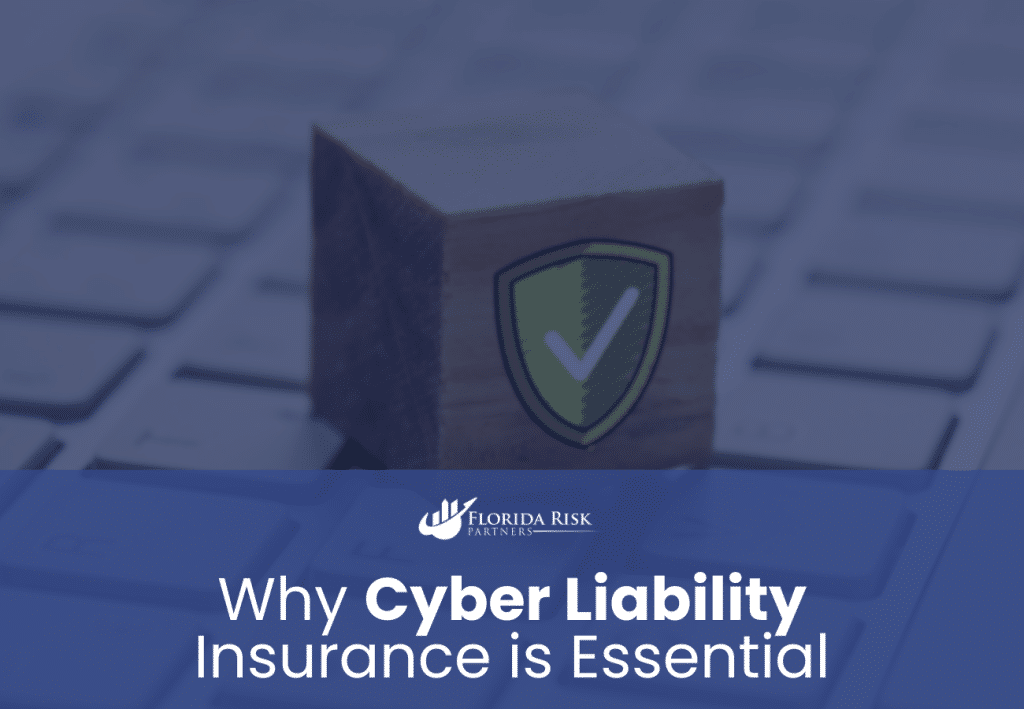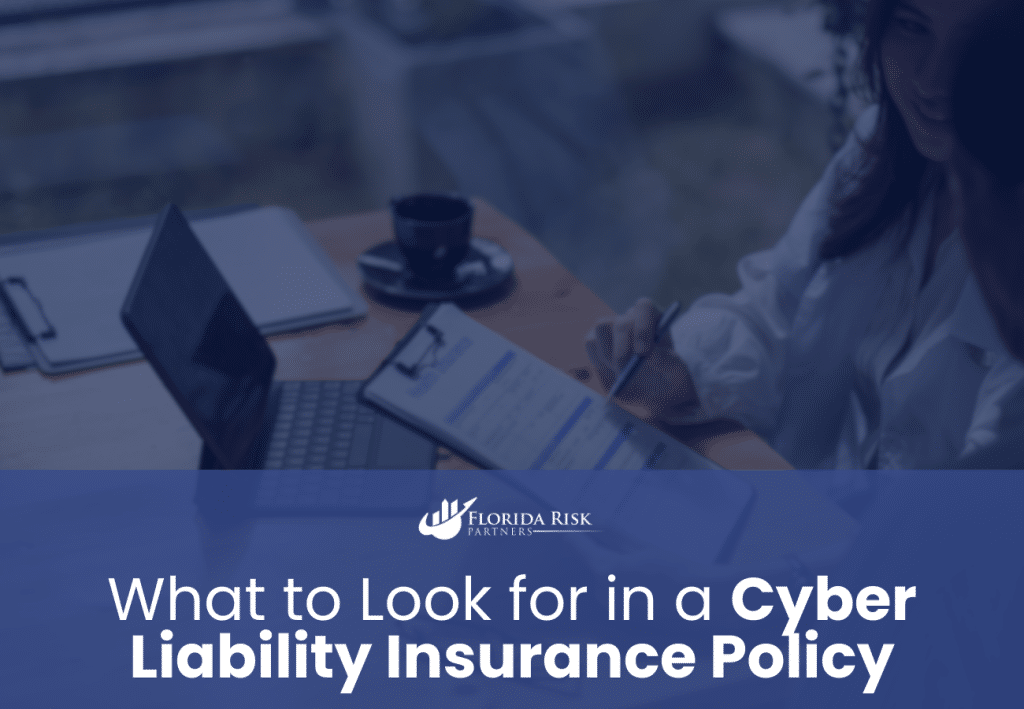-
Main Office: 1434 E. Bloomingdale Ave Valrico, FL 33596-6110
-
Phone: (888) 601-6660
-
Email: info@floridariskpartners.com

In today’s interconnected world, cyber threats are an ever-present danger for businesses of all sizes. Whether it’s a ransomware attack, a phishing scam, or a data breach, the financial and operational fallout of a cyber incident can be devastating. While cybersecurity measures like firewalls and antivirus software are essential, they can’t guarantee complete protection against increasingly sophisticated threats. That’s where cyber liability insurance comes in.
This comprehensive guide will introduce you to the fundamentals of cyber liability insurance, explaining why it’s a critical safety net for your business and how it integrates with your overall cybersecurity strategy. By the end of this post, you’ll have a clear understanding of how cyber liability insurance works, what it covers, and why it’s a must-have in today’s digital age.
What is Cyber Liability Insurance?
Cyber liability insurance is a specialized form of business insurance that protects against the financial impacts of cyber incidents. Unlike traditional policies, which focus on physical risks like property damage or bodily injury, cyber liability insurance is designed to address digital risks that threaten your data, systems, and reputation.
This coverage can be divided into two main categories:
- First-party coverage: Protects your business from direct losses caused by a cyber incident. Examples include costs related to data recovery, business interruption, and breach notifications.
- Third-party coverage: Shields your business from liabilities arising from claims made by others, such as customers or regulatory authorities, due to a data breach or other cyber-related event.
Together, these coverages provide a financial safety net to help your business recover from the costly effects of a cyber incident.
Why Cyber Liability Insurance is Essential
Many business owners mistakenly believe they’re not at risk of a cyberattack. They assume that hackers only target large corporations, or that their existing IT security measures are enough to keep them safe. Unfortunately, these assumptions can leave businesses dangerously exposed.
Small Businesses Are Prime Targets
Over 40% of cyberattacks target small and mid-sized businesses, according to industry reports. Hackers view these companies as easier targets due to limited resources and less robust cybersecurity defenses. A single breach can lead to financial losses, reputational harm, and even legal action.
Cybersecurity Measures Aren’t Foolproof
While firewalls, antivirus software, and employee training are essential, no system is entirely immune to cyber threats. Human error, evolving attack methods, and unpatched vulnerabilities can all create opportunities for hackers.
The Financial Impact of a Cyber Incident
The costs of a cyberattack can be staggering. From regulatory fines and legal fees to the expense of restoring systems and notifying affected customers, businesses can face financial losses that far exceed their resources. Cyber liability insurance provides the financial support needed to navigate these challenges.

What Does Cyber Liability Insurance Cover?
Cyber liability insurance offers comprehensive protection across a range of scenarios. Here’s an overview of the key areas of coverage:
First-Party Coverage
- Data Breach Response Costs: Covers the cost of notifying affected individuals, providing credit monitoring, and hiring forensic experts to investigate the breach.
- Business Interruption: Compensates for lost revenue and additional expenses incurred when a cyber incident disrupts your operations.
- Ransomware Payments: Helps pay ransom demands (where legally permitted) and the costs of negotiating with attackers.
- Data Restoration: Covers the cost of recovering or recreating lost or corrupted data.
- Crisis Management and PR: Provides funds to hire PR specialists and manage communications to protect your reputation after an incident.
Third-Party Coverage
- Legal Defense Costs: Covers attorney fees and court costs if your business is sued due to a cyber incident.
- Regulatory Fines: Helps pay fines imposed by regulatory authorities for failing to protect sensitive data.
- Settlement Payments: Covers damages awarded to plaintiffs in lawsuits related to a breach.
- Media Liability: Protects against claims of defamation or copyright infringement related to your online content.
Optional Endorsements
Many policies offer optional coverages to address specific risks, such as:
- Social Engineering Fraud: Protects against scams that trick employees into transferring funds or sharing sensitive information.
- Dependent Business Interruption: Covers losses caused by outages at third-party vendors or partners.
What to Look for in a Cyber Liability Insurance Policy
Choosing the right policy can feel overwhelming, especially if you’re unfamiliar with the terminology or nuances of coverage. Here are some critical features to consider:
Policy Limits and Sublimits
The policy limit is the maximum amount the insurer will pay for a claim, while sublimits may cap payouts for specific expenses, such as business interruption or ransomware payments. Ensure the policy limits are adequate to cover your potential losses.
Retroactive Coverage
Cyber incidents are often discovered months after they occur. Look for a policy that includes retroactive coverage to protect against incidents that happened before the policy was purchased but were discovered later.
Incident Response Services
Many policies include access to breach response teams, which provide forensic experts, legal counsel, and crisis management support. This immediate assistance can be invaluable in minimizing damage and restoring operations.
Exclusions
Understand what the policy doesn’t cover, such as intentional employee misconduct, known vulnerabilities, or cyberattacks attributed to acts of war.

How to Integrate Cyber Liability Insurance into Your Risk Management Strategy
Cyber liability insurance works best as part of a broader cyber risk management strategy. Here’s how to integrate it effectively:
- Conduct a Risk Assessment
Identify your vulnerabilities and evaluate the potential financial impact of a cyber incident. This will help you determine the level of coverage you need. - Develop an Incident Response Plan
Create a step-by-step plan for detecting, responding to, and recovering from cyber incidents. Ensure your plan incorporates the resources provided by your insurance policy. - Invest in Employee Training
Educate your staff about phishing scams, password hygiene, and other cybersecurity best practices. Human error is one of the leading causes of cyber incidents. - Use Advanced Cybersecurity Tools
Complement your insurance with tools like firewalls, intrusion detection systems, and data encryption. - Review and Update Your Policy Regularly
As your business evolves, ensure your cyber liability policy keeps pace with new risks and operational changes.
Common Misconceptions About Cyber Liability Insurance
“I’m Too Small to Be Targeted”
Even small businesses are vulnerable to cyberattacks. Hackers often view them as low-hanging fruit due to weaker defenses.
“My IT Security Measures Are Enough”
While cybersecurity tools are essential, they can’t guarantee complete protection. Cyber liability insurance provides a financial safety net for when preventive measures fail.
“It’s Too Expensive”
The cost of insurance is a fraction of the potential expenses of a cyber incident. Policies can be tailored to fit your budget and risk profile.
Take Action: Protect Your Business Today
Cyber threats are a reality of the digital age, and every business—large or small—needs a plan to manage them. Cyber liability insurance is an essential component of that plan, offering financial protection and peace of mind in the face of uncertainty.
To dive deeper into this critical topic and gain a detailed understanding of how cyber liability insurance can safeguard your business, download our free e-book: “Understanding Cyber Liability Insurance: Protecting Your Business in a Digital World.” Packed with expert insights, actionable advice, and real-world examples, this guide will empower you to make informed decisions about your cybersecurity strategy.
Call to Action
Don’t wait until it’s too late. Download the e-book and take the first step toward protecting your business from cyber threats.
Download Our Complimentary Guide to Purchasing Cyberliability Insurance
By educating yourself and investing in the right protection, you can secure your business’s future in an increasingly connected world.
Call Us Or
Schedule an Appointment
Select an agent below to view our online calendars and select a day and time that works best for you or call us directly at 888-601-6660. When you use our online calendars, you will receive an email with more information.



